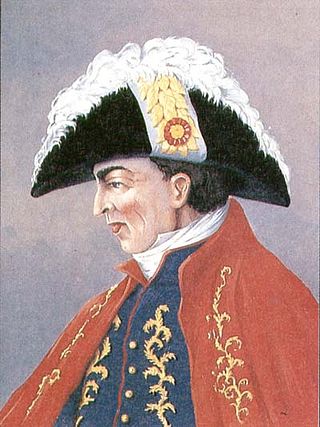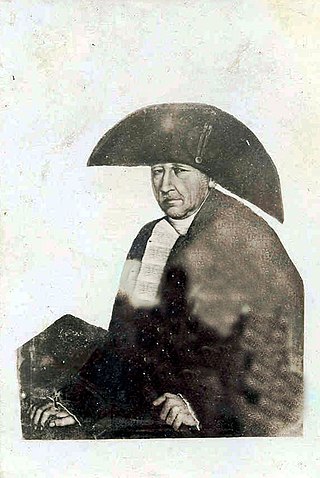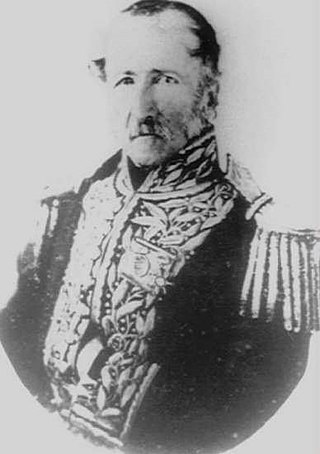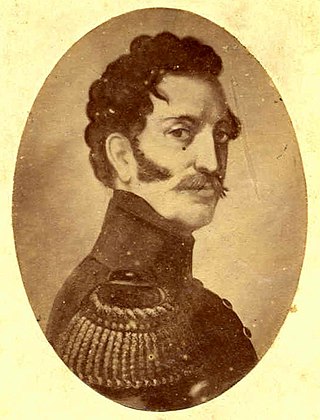
Francisco José de Paula Santander y Omaña was a Neogranadine military and political leader who served as Vice-President of Gran Colombia between 1819 and 1826, and was later elected by Congress as the President of the Republic of New Granada between 1832 and 1837. Santander played a pivotal role in the Colombian War of Independence being one of the main leaders of the Patriot forces and helped lead the Patriot Army alongside Simón Bolívar to victory. He's often credited with creating the legal foundations for democracy in Colombia, as well as creating the country's first system of public education. For these reasons he is considered a National Hero in Colombia and has thus commonly been known as "The Man of the Laws" as well as the "Organizer of Victory".

Antonio Amador José de Nariño y Álvarez del Casal, was a Colombian ideological precursor of the independence movement in New Granada as well as one of its early political and military leaders. In 1793 he published the first French to Spanish translation of the Declaration of the Rights of Man and of the Citizen in Spain's American colonies.

José Camilo Clemente de Torres Tenorio was a Neogranadine independence leader and lawyer who also served as president of the United Provinces of New Granada. He is credited as being an early founder of the nation due to his role in early struggles for independence from Spain.

Manuel Atanasio Girardot Díaz was a Neogranadine military officer and one of the heroes of the Colombian and Venezuelan wars of Independence. He is famous for having died during the Battle of Bárbula, trying to plant the republican flag on Bárbula Hill.

The First Republic of New Granada, known despectively as the Foolish Fatherland, is the period in the history of Colombia immediately following the declaration of independence from Spain in 1810 and until the Spanish reconquest in 1816. The period between 1810 and 1816 in the Viceroyalty of New Granada was marked by such intense conflicts over the nature of the new government or governments that it became known as la Patria Boba. Constant fighting between federalists and centralists gave rise to a prolonged period of instability that eventually favored Spanish reconquest. Similar developments can be seen at the same time in the United Provinces of the Río de la Plata. Each province, and even some cities, set up its own autonomous junta, which declared themselves sovereign from each other.

Manuel de Bernardo Álvarez del Casal was an influential Criollo figure in New Granada at the time of the independence movement. He occupied several important positions in the rebel government. He was also the uncle of Antonio Nariño, forerunner of independence. He served as president of the rebel State of Cundinamarca in 1814.

The United Provinces of New Granada was a country in South America from 1810 to 1816, a period known in Colombian history as la Patria Boba. It was formed from areas of the New Kingdom of Granada, roughly corresponding to the territory of modern-day Colombia. The government was a federation with a parliamentary system, consisting of a weak executive and strong congress. The country was reconquered by Spain in 1816.

Francisco José de Caldas was a Neogranadine lawyer, military engineer, self-taught naturalist, mathematician, geographer and inventor, who was executed by orders of General Pablo Morillo during the Spanish American Reconquista for being a forerunner of the fight for the independence of New Granada. Arguably the first Colombian scientist, he is often nicknamed "El Sabio".

Juan José Francisco de Sámano y Uribarri de Rebollar y Mazorra, was a Spanish military officer and the last viceroy of New Granada from March 9, 1818 to August 9, 1819, during the Colombian War of Independence.

Antonio Clemente José María Bernabé Ricaurte Lozano was a patriot of the Independence of Colombia and Venezuela and captain of Bolívar's army. He is remembered as the martyr of the Battle of San Mateo, where, in a heroic action, he blasted an enemy stronghold by immolating himself.
The constitutional history of Colombia is the process of formation and evolution of the different constitutions that Colombia has had since its formation.

Manuel Benito de Castro was a Neogranadine politician. He became President of the State of Cundinamarca in 1812 in place of Antonio Nariño.

Joaquín París y Ricaurte was a Colombian military officer and politician who fought in the Colombian War of Independence and various civil wars that took place in Colombia during the 19th century. París was later also commander-in-chief of the army and Secretary of War on various occasions.

The Colombian War of Independence began on July 20, 1810 when the Junta de Santa Fe was formed in Santa Fe de Bogota, the capital of the Spanish colonial Viceroyalty of New Granada, to govern the territory autonomously from Spain. The event inspired similar independence movements across Latin America, and triggered an almost decade-long rebellion culminating in the founding of the Republic of Colombia, which spanned present-day Colombia, mainland Ecuador, Panama, and Venezuela, along with parts of northern Peru and northwestern Brazil.

The Free and Independent State of Cundinamarca was a rebel state in colonial Colombia. It included parts of the former New Kingdom of Granada. The state originated as a result of the Foolish Fatherland period at the beginning of the Spanish American wars of independence. Its capital was Bogotá, the former capital of the Viceroyalty of New Granada.

José María Cabal Barona was a Neogranadine military and political leader who fought in the Colombian War of Independence.

Manuel del Castillo y Rada was a Neogranadine general, who fought for the independence of New Granada from Spain. He was executed during the Spanish Reconquista after the Siege of Cartagena (1815), by order of Pablo Morillo.

The Nariño Southern Campaign was a series of military actions between December 1813 and May 1814, under command of Antonio Nariño, leader of the Republican State of Cundinamarca, against Spanish forces in the south of New Granada.
It had the objective of dislodging the Royalist presence in the south after the defeat of the first independence movement in the province of Quito (1812), a fact that put the New Granada provinces, that had retained their early independence, at risk. Nariño's army took the city of Popayán and the surroundings of Pasto, but was decisively defeated in the Battle of Ejidos de Pasto, ending the campaign in total failure.

The Pasto Campaign was a series of military operations carried out between 1822 and 1824 by Gran Colombia against the Royalist strongholds of San Juan de Pasto and Patía, Cauca in present-day Southern Colombia.

Emmanuel Roërgas de Serviez, known by the Hispanicized name of Manuel Roergas de Serviez, was a French soldier and adventurer who participated in the wars of independence in South America.


















